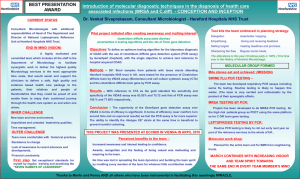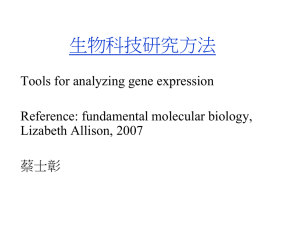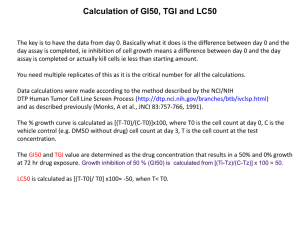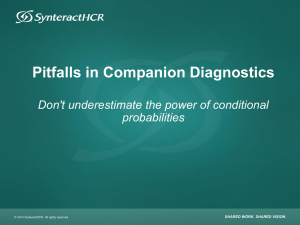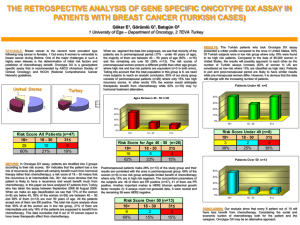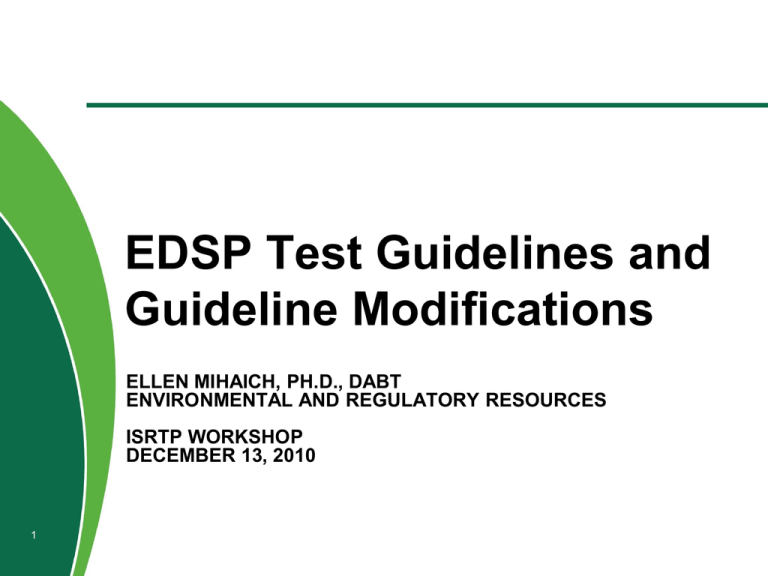
EDSP Test Guidelines and
Guideline Modifications
ELLEN MIHAICH, PH.D., DABT
ENVIRONMENTAL AND REGULATORY RESOURCES
ISRTP WORKSHOP
DECEMBER 13, 2010
1
2
Courtesy of Tim Ward-ABC Laboratories
890 Series In Vitro Screens
Tier 1 Assay
3
Guideline
Estrogen Receptor (ER)
Binding Assay
USEPA 890.1250
Estrogen Receptor
Transcriptional Activation
Assay
USEPA 890.1300
OECD 455
Androgen Receptor (AR)
Binding Assay
USEPA 890.1150
Aromatase Assay
USEPA 890.1200
Steroidogenesis Assay
USEPA 890.1550
Purpose
An ER binding assay that utilizes rat uterine cytosol to
examine the ability of a test chemical to bind with
estrogen receptors
An second type of ER binding assay that uses a human
cell line to examine the ability of a test chemical to
bind with estrogen receptors and alter gene
transcription
An AR binding assay that utilizes rat prostate cytosol
to examine the ability of a test chemical to bind with
androgen receptors
Aromatase is an enzyme complex responsible for
estrogen biosynthesis that converts androgens into
estrogens, estradiol, and estrone. The Aromatase in
vitro assay uses a human recombinant form of the
protein and focuses on this portion of the
steroidogenic pathway to detect substances that
inhibit aromatase activity.
The Steroidogenesis in vitro assay utilizes the H295R
human adrenocortical carcinoma cell line to detect
interference with the body’s production of male and
female steroid sex hormones (estrogen and
testosterone).
890 Series In Vivo Screens
Tier 1 Assay
4
Guideline
Uterotrophic Assay
USEPA 890.1600
OECD 440
Hershberger Assay
USEPA 890.1400
OECD 441
Male Pubertal Assay
USEPA 890.1500
Female Pubertal Assay
USEPA 890.1450
Fish Short-Term
Reproduction Assay
USEPA 890.1350
OECD 229
Amphibian Metamorphosis
Assay
USEPA 890.1100
OECD 231
Purpose
Ovariectomised or immature female rats are used to
screen for estrogenic effects by measuring uterine
weight changes.
Designed to detect chemicals that are androgenic, antiandrogenic or inhibit 5α-reductase. Accessory sex gland
weights, including several androgen-dependent tissues,
are measured in castrated or immature male rats
Androgenic, anti-androgenic, and thyroid activity is
screened in male rats during sexual maturation.
Abnormalities associated with sex organs and puberty
markers, as well as thyroid tissue are examined.
Estrogenic and thyroid activity is screened in female
rats during sexual maturation. This assay examines
abnormalities associated with sex organs and puberty
markers, as well as thyroid tissue.
Screens for estrogenic and androgenic effects. The assay
examines abnormalities associated with survival,
reproductive behavior, secondary sex characteristics,
histopathology, and fecundity (i.e., number of spawns,
number of eggs/spawn, fertility, and development of
offspring) of fish exposed to test chemicals.
Involves the use of tadpoles to determine if chemicals
affect the thyroid during metamorphosis and
consequently result in developmental effects.
Test Order Restriction
Requirement to perform screens according to
890 series guideline
“…you may not deviate from an approved testing
protocol unless you first consult with the Agency and
obtain Agency approval of any planned deviation.”
5
General and Specific Guideline
Issues
• Primarily hitting the high points of some of
the screens today
• For more information please see the Test
Guideline comments sent by the EPF in the
EPA docket:
EPA-HQ-OPP-2009-0634-0135
6
General Guideline Issues
*No public review of guidelines prior to publication
• Very prescriptive and inflexible
• Test validity criteria too stringent
• Sensitivity and specificity issues
• Typographical errors
• No standard evaluation procedures
• No defined Weight of Evidence Procedures for the
battery
7
ER and AR Binding Assays
Shortcomings
No metabolic capability
Impacted by pH, denaturation, precipitates and
particulates
Cannot distinguish agonists/antagonists
Validation and Guideline Issues
Inconsistency in rat uterine cytosol preparation
Inconsistency in cytosolic prostate gland preparation
Numerous typographical errors
8
ER Transcriptional Activation
Shortcomings
No metabolic capability
Validation and Guideline Issues
Only validated for ER agonists
Limited validation and false positive rate high
EPA’s recommendation for positive response (PC10)
deviates from peer review recommendation
EPA’s acceptable lower level of dynamic range of 4fold induction raises issue of distinguishing from
background noise
9
Aromatase (Human Recombinant)
Shortcomings
No metabolic capability
Impacted by denaturation of protein
Validation and Guideline Issues
Limited validation
Numerous typographical errors
10
Steroidogenesis (Human Cell Line)
• Shortcomings
Cytotoxicity confounds results
Presence of any detergent residue on glassware can
confound assay results
• Validation and Guideline Issues
High variability between laboratories during
validation make the results difficult to interpret
The guideline is poorly organized with no stated
purpose – more of a protocol than guidance
Very small pipetting volumes could lead to errors
Parallel evaluation of cytotoxicity needed.
Guideline permits up to 20% cytotoxicity while
ICCVAM recommended only 10%
11
Uterotrophic
• Shortcomings
Route of administration and animal model compared
to relevance
• Validation and Guideline Issues
While there are references to the anti-estrogenic
component of the study, there has been no
validation of this and anti-estrogenicity should not
be assessed
Dose route and animal model preferences not
harmonized with OECD - environmental relevance
and metabolism should be considered
12
Hershberger
• Validation and Guideline Issues
13
Wide inter-laboratory variation in the mean age at
which preputial separation occurs
Clarity needed for the interpretation of study with
and without optional endpoints
EPA recommends use of multivariate analyses of all
accessory sex organ weights in cases where only a
single tissue gives a significant response; such posthoc analyses are useful for hypothesis generation,
but should not be used in hypothesis testing
Anesthetic agent and euthanizing method should be
chosen carefully to avoid artifacts if performing
optional steroid measurement
CV’s for control and high dose organ weights should
be reported. Deviation of more than 3 could result
in study rejection
Pubertals
• Shortcomings
High sensitivity but low specificity
Apical endpoints provide only limited information on
the mode of action for potential endocrine-active
chemicals
Significant inherent biological variability in the
endpoints (puberty onset, estrous cycle, organ
weights) complicates interpretation
• Validation and Guideline Issues
Validation studies did not demonstrate a negative
response using a true negative control agent
Dose selection is critical to avoid non-specific
outcomes
14
Amphibian Metamorphosis
• Shortcomings
Apical endpoints with unknown specificity
Poorly soluble or unstable compounds difficult to
test
Not a short screen
• Validation and Guideline Issues
No known negative compounds
Dose setting guidance needed
Background levels of iodide in food and water may
make comparison between labs difficult
Developmental staging
15
Fish Short-Term Reproduction
• Shortcomings
Multiple modes of action detected – apical endpoints
Medium sensitivity, low specificity
Long and expensive “screen”
• Validation and Guideline Issues
High variability observed in plasma sex steroids
suggests they are not particularly robust endpoints
Statistical power of the fecundity endpoint is low
Limited quantities of blood plasma may require
prioritization of most robust measurements, such as
vitellogenin, rather than sex steroids
Dose setting is critical to avoid confusing systemic
toxicity with genuine endocrine-mediated effects
16
Sensitivity and Specificity
The Series 890.1350 TG (fish assay) states:
"It is recognized that some endpoints may be
responsive to nonendocrine stresses in addition to
endocrine-mediated pathways, particularly fecundity.
Although reductions in fecundity indicate adverse
organismal and, potentially, population level effects
(i.e., reproductive toxicity), these cannot be
definitively distinguished from direct endocrinemediated effects by this assay when changes in other
core endpoints are not present. Nevertheless,
reductions in fecundity are considered a positive effect
in this assay because they may be endocrine-mediated
..."
17
Staging the Conduct of the Screens
Stage 1
Stage 2
Stage 3
Stage 4
18
•Estrogen Receptor (ER) Binding
•Androgen Receptor Binding
•ER Transcriptional Activation
•Uterotrophic Assay
•Hershberger Assay
•Aromatase Assay
•Steroidogenesis Assay
•Male Pubertal Assay
•Female Pubertal Assay
•Fish Short-Term Reproduction Assay
•Amphibian Metamorphosis Assay
Summary
• The current US EPA EDSP falls short in meeting
many of the attributes of an efficient and
effective screening program.
19
Many of the assays are not mechanistic, and some
have yet to be shown to meet the basic requirement
of distinguishing an endocrine active substance from
a negative control or differentiating potential
endocrine-mediated responses from responses via
other modes of action (e.g. hepatotoxicity) or
systemic toxicity.
The prescriptive nature of the guidelines combined
with typographical errors, overly conservative
validity criteria, and inflexible test order
requirements likely mandate protocol approval prior
to conducting the tier 1 battery
Summary-cont.
• A staged approach to the performance of the
screens may improve the interpretability of
the results, increasing the efficiency of the
work and clarity of the results.
Efficiency and clarity are essential because
interpretation of the entire battery is the
determinant for proceeding to Tier 2.
20
• While staging the EDSP ESB may improve
interpretation as to whether a substance may
interact with components of the estrogen,
androgen, and thyroid hormone systems, such
activities cannot overcome inherent
limitations of the tier 1 screens.
• EPA EDSP ESB Test Guidelines can be
accessed at
http://www.epa.gov/ocspp/pubs/frs/publications
/Test_Guidelines/series890.htm
21


